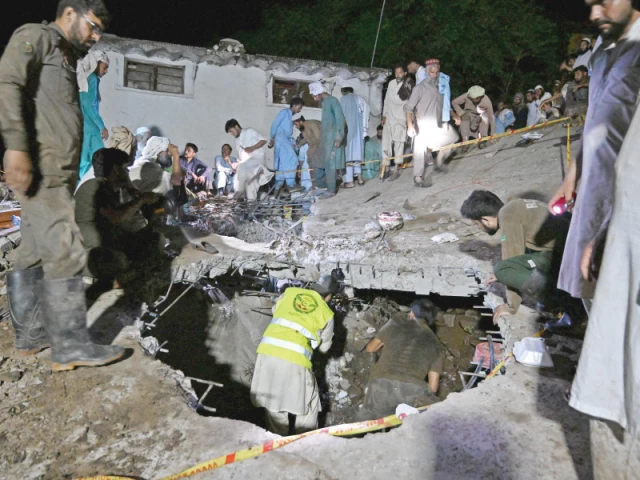SWABI:
Flash floods triggered by a powerful cloudburst and lightning struck the remote mountainous region of Gadoon-Amazai in Swabi district, Khyber-Pakhtunkhwa (K-P) early Monday, leaving at least 25 people dead and 35 others injured.
Entire villages were submerged as torrential waters swept away homes, livestock, and infrastructure, adding to the mounting toll of this year’s devastating monsoon season. “A cloudburst in Swabi completely destroyed several houses,” a district official told AFP.
According to locals, the sudden surge of gushing water destroyed dozens of houses in Dalori Bala, Sarkoi Payan, and Karnal Sher Kallay villages, burying families under mud and rubble. “At least 40 people are still missing,” a local resident said.
Swabi Deputy Commissioner Nasrullah Khan confirmed that 20 people perished in Dalori Bala alone, with only 10 bodies recovered so far. In Sarkoi Payan, two women and their children were swept away, while in Karnal Sher Kallay, a young man drowned in floodwaters.
Elsewhere, landslides buried vehicles in Bada village, and several roofs collapsed in Kolagar. The causeway linking Topi with Marghuz and Zaida was swept away, while electricity pylons and mobile communication networks crumbled under the force of the rains.
Two Pakistan Army helicopters were dispatched to airlift survivors, while Rescue 1122 teams from Swabi, Mardan, Nowshera, and Haripur joined operations. Tayyab Abdullah, director general of Rescue 1122, reached Swabi to personally supervise the mission, deploying more than 90 personnel, 13 ambulances, disaster vehicles, water units, and specialised equipment.
The Provincial Disaster Management Authority (PDMA) reported that the overall monsoon death toll in K-P had reached 341, including 222 in Buner district alone. At least 178 others were injured, and 420 houses damaged.
Across the province, torrential rains triggered more flooding and landslides that swept away entire settlements. Relief work was hampered by continuous rains, with fresh spells threatening more flash floods in the coming days.
Buner, the hardest hit district, saw 12 villages wiped out last week. “This morning fresh rains forced a halt to relief operations,” said volunteer Nisar Ahmad, 31, who has been digging through rubble to retrieve bodies.
He added that 219 corpses had already been recovered. “Dozens more are still buried under mud and rocks, and can only be recovered with heavy machinery. But the makeshift tracks we built to access the villages have once again been washed away.”
Other affected districts include Swat, Bajaur, Mansehra, Shangla, Lower Dir, Battagram, and surrounding areas, PDMA said. “These extreme weather events have severely impacted communities, leaving many displaced and in urgent need of assistance,” a PDMA official said.
Meanwhile, a stormy downpour resulted in the collapse of a roof in the Pabbi Choky Mamrez area in Nowshera district, claiming the lives of a couple. In Lower Dir, continuous rainfall has caused streams and drains to overflow, significantly raising the water level of the Panjkora River.
Fear and desperation gripped survivors. Ghulam Hussain, 35, a resident of Buner, recalled: “Even if it rains a little now, we feel scared. That day, it started with light rain and then people were suddenly swept away.” Food and water shortages have emerged as a serious concern.
“Many livestock have also perished in the cloudburst, and their decomposing bodies are spreading a foul odour,” volunteer Ahmad warned. “Right now, our most urgent need is clean drinking water, and I appeal to the government to provide it.”
On the directives of Chief Minister Ali Amin Gandapur, the K-P government released Rs3 billion for relief and rehabilitation – half for immediate assistance and half for repair of roads and communication networks.
Authorities also dispatched 89 truckloads of tents, bedding, mosquito nets, food, and essentials. Mobile hospitals, dewatering pumps, and emergency camps were set up, with more than 5,000 people rescued so far.
At a high-level meeting, the chief minister pledged that all available resources would be mobilised for immediate relief and long-term rehabilitation. “The provincial government will not abandon the people in this hour of need,” he said.
Nationwide, the National Disaster Management Authority (NDMA) reported that heavy monsoon rains have killed over 650 people and injured more than 920 since June. Preliminary estimates put damages to public and private property at more than Rs126 million.
Tarbela near full
Meanwhile, the PDMA said the rain spell would continue until August 21. The latest weather advisory highlights that heavy rainfall is predicted for K-P’s Peshawar, Swat, Hazara, Mansehra, Abbottabad, and Chitral regions. Moderate to heavy rainfall is also expected in Punjab and Sindh it added.
Following continuous rainfall in K-P, Gilgit Baltistan (G-B) and Azad Jammu and Kashmir (AJK), the water level in the dams is rising. The water level in Tarbela Dam surged to 1,547 feet, bringing it within just three feet of its maximum capacity, officials said.
For the third consecutive day, the dam’s spillways remained open to manage the mounting pressure. According to the latest data, the inflow of water stands at 345,000 cusecs, while the outflow has reached 381,000 cusecs.
The Indus River at Tarbela is currently witnessing a medium-level flood situation, though authorities have warned that if the flood torrents gain further intensity, the water discharge could climb to 450,000 cusecs.
In anticipation of rising waters, officials have advised riverside communities to exercise caution, while a complete ban has been imposed on tourist visits to riverbanks to prevent mishaps. Authorities continue to monitor the situation closely as the monsoon rains persist.
(WITH INPUT FROM OUR PESHAWAR CORRESPONDENT & AFP)

